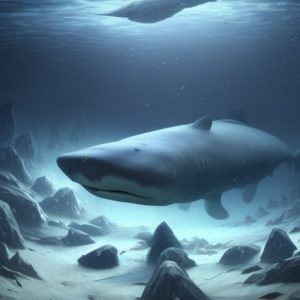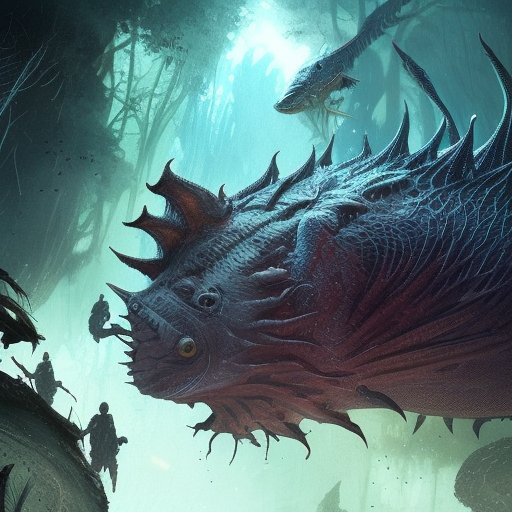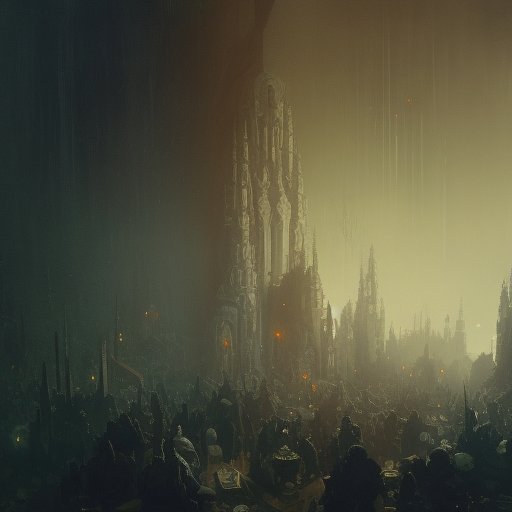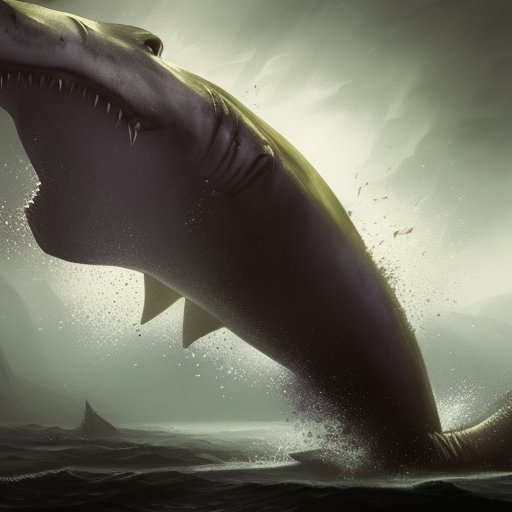
Welcome, space cadets, to an intergalactic journey into the depths of the ocean. Today, we take a dive into the enigma of the Greenland shark. This primitive and exotic creature has roamed our waters for over 400 years, and it’s still hard to imagine how old they can get. From their unique hunting techniques to their long lifespan, we’ll uncover the secrets of this elusive apex predator. But, as our world changes, so does theirs. So join us as we explore the past, present, and future of the Greenland shark, and what it means for our delicate ecosystem. Let’s get ready to dive in!
I. Introduction
Greetings, fellow space adventurers! Today, we dive deep into the Earth’s oceanic abyss to explore the mystery of the legendary Greenland shark. The harsh, cold waters of the Arctic have been the abode of this predatory giant for centuries beyond count, yet its specificities and behaviors have only been discovered by humans quite recently. Scientists remain enthralled by its unique physiological, biological, and ecological features. With their hearty tolerance for cold water, Greenland sharks have outlived empires and kingdoms, and their struggles and achievements can teach us more than just the biology of the sea, but also lessons on resilience, adaptability and survival in the face of overwhelming odds.

So let us delve into the unknown depths and find out about the life and times of these majestic creatures, the oldest vertebrate animal in the world. Travel with us on this journey into the ecologically intriguing and enigmatic life of the Greenland shark, as we unravel its secrets and discover the features that have allowed it to survive in the harsh, freezing waters of the Arctic. How did they evolve? What makes them unique amongst other sharks? How long do they live? How do they feed? What threats face their survival, and what can be done to conserve this remarkable species?
Stay tuned to unravel the secrets of the oldest living vertebrate animal in the world, as we dive into the treacherous waters of the Arctic and explore the mysteries of the ageless Greenland shark. Join us and let’s navigate through the dark, unknown depths teeming with life to uncover the exciting world of the Greenland sharks!
II. Evolution and Adaptation of Greenland Sharks
In the frigid, northern waters of the Arctic, the Greenland shark has had a long evolutionary journey, uniquely suited for survival in this harsh environment. With their slow growth and late maturity, these predators have few natural predators of their own, and adapt through powerful modes of evolution that have allowed them to exist for more than 400 years. Their distinctive physiological adaptations, such as their capacity to survive in cold and dark waters with limited food supplies, make them valuable subjects for marine biologists around the world.

One of the most fascinating aspects of the Greenland shark’s adaptation is its chemical sensing organs, used to detect prey hundreds of meters away. These organs work alongside the sharks’ unique and peculiar hunting behaviors, and the combination of these factors is key in delivering the largest concentration of urea of any animal on the planet. This can cause its flesh to be toxic, a fact unknown to many Arctic inhabitants.
Thus, the Greenland shark’s evolution and adaptation is built upon a combination of unique characteristics including its slow growth, late maturity, cold tolerance, and amazing senses. This species is nothing short of a miraculous example of evolutionary success that has withstood the test of time, and continues to thrive in harsh Arctic conditions.
However, much work remains to be done concerning the Greenland shark’s life cycle and behaviors. More research is needed to gain greater insight into the many adaptations that make this species uniquely equipped for survival in our ever-changing oceans. So join us, as we discover the wonders of the evolutionary journey that has forged these age-old predators into the remarkable creatures that they are today.
III. Lifespan and Reproduction of Greenland Sharks
As we continue our exploration of the incredible Greenland shark, we dive deep into their lifespan and reproduction. These cold-blooded creatures can live for over 400 years, easily surpassing any other vertebrate’s lifespan to set a record for the oldest living animal. Their lengthy lifespans may be due to their slow metabolic rate, which allows them to age slowly and accumulate fewer age-related damages that can otherwise shorten life.

Greenland sharks are mysterious creatures, and not much is known of their reproductive cycle. Researchers believe that female Greenland sharks reach reproductive maturity around the age of 150 years, and carry their pups for extended periods, perhaps as long as 18 months. It is also believed that Greenland sharks mate only once every six to ten years.
Interestingly, the belly of a one female Greenland shark can contain as many as 10 fetuses! But unlike with most sharks, where eggs are fertilized outside of the womb, the fertilization process happens inside the female’s womb, which leads scientists to label the Greenland shark as viviparous (that is, giving birth to living offspring). Studies suggest that this species may use counter-current heat exchange to help incubate their young, which could explain how they’re able to do so in the cold, low-temperature waters of the Arctic.
One of the most intriguing factors of their reproductive cycle, though, is how slowly they grow. This adds to the mystery of why they live so long. Also, studies found that Greenland sharks grow at a slower rate the older they get, which implies that their age and size are linked, but just how long it takes for a Greenland shark to reach its full size is not known. In summary, these creatures are truly unique when it comes to reproduction and aging, rendering them as the extraterrestrial equivalent of earth-bound centenarians.
IV. Hunting and Feeding Habits of Greenland Sharks
Greenland sharks are known for their unique hunting and feeding habits, which are quite fascinating. These sharks are not picky eaters; in fact, they are some of the most scavenging creatures in the ocean, often consuming anything they come across, even garbage. They have been found to consume fish, seals, dolphins, and even polar bears, which are as large as they are.

To the Greenland shark, hunting is like a strategic game in which they are the undefeated champions. They are slow-moving creatures, but their massive size and silent movements make them deadly ambush predators. They have been known to go weeks without food, which means they do not need to eat regularly.
The hunting behaviors of these sharks are not fully known, but their stomachs have been found with strange contents such as rocks, seals, other sharks, and even reindeer. It is believed that they move slowly along the ocean floor, using their heightened senses to detect prey in their surroundings, primarily through their sense of smell, electroreception, and mysterious sixth sense that is not entirely known.
Like all sharks, the Greenland shark has an excellent sense of hearing, some studies suggest that they utilize their hearing ability for echolocation. This unique hunting technique allows them to locate prey easily in the murky waters of the Arctic, helping them choose where to hunt.
V. Threats and Conservation Status of Greenland Sharks
Unfortunately, these magnificent creatures face many dangers in their harsh world. Commercial fishing, climate change, and pollution are all major threats to the survival of the Greenland shark. These ancient beasts are accidentally caught in oceanic traps and lost fishing nets, making up a large share of bycatch in fisheries. Climate change is altering the Arctic ecosystem rapidly, leading to a lack of food for the Greenland sharks. The increased levels of pollution in the ocean have contaminated their habitats, leading to bioaccumulation of harmful toxins in their bodies. This further disrupts their reproduction and threatens their long-term survival as humans carrying the legacy of the economy prioritize their economic gains over conservation efforts.

Human activities on our planet are pushing the limits of sustainable development and have put many species under threat, including the Greenland shark. These gentle giants, live-long survivors of the Arctic, need protection from humans who care more about profit and consumption than biodiversity. The only way for conservation to be successful is through global cooperation from governments and organizations working together to create sustainable policies that respect the biodiversity of oceanic creatures.
Whether it is in deep blue oceans, across space galaxies, or into otherworldly dimensions, protecting the diversity of life should be our top priority. The Greenland shark has survived the test of time, but now it needs our help, the survival of the species is in our hands. Only time will tell whether we are willing to preserve the beauty of its existence, or whether we will let it fade away into extinction. But what future do we want? A world of lifeless seas, devoid of diversity and color or a thriving, vibrant world where every creature, big or small, is respected, and allowed to coexist in harmony? The choice is ours, so let us make the right one for the sake of the Greenland shark and all the other species that call our planet home.
VI. The Future of Greenland Sharks in a Changing Environment
As our planet continues to face global climate changes, the future survival of the Greenland shark remains uncertain. Habitat destruction, pollution, overfishing and climate changes continue to pose a severe threat to this ancient species. The pristine, cold-water environment that Greenland sharks call home is shrinking, warming up, and becoming more acidic as atmospheric CO2 continues to increase, making it difficult for the sharks to adapt. As a result, their geographic range is projected to shift towards colder and deeper waters, where they will compete with other predators for food.

Although researchers have learned a lot about the Greenland shark, much remains to be understood to ensure their survival. It is essential for us to focus on the preservation and protection of this magnificent species. We need to take concrete steps to reduce the impacts of climate change, such as decreasing our carbon footprint by using more renewable energy, and protecting their habitats by minimizing pollution and preventing overfishing of their valuable prey.
As a society, we must also recognize the cultural and ecological importance of the Greenland shark, and strive to preserve its place in the food web and traditional Arctic societies.
Though the future of the Greenland shark is ominous, there is still hope. With the collective efforts of scientists, conservationists, and governments, we can work together to preserve the existence and cultural importance of this ancient species, ensuring it remains an integral part of our diverse and complex marine ecosystems. Let us take a cue from the resilience of the Greenland shark, and brave the challenges of the present and future to save our beloved ocean-bound friends.
VII. Conclusion
And so, our journey through the lives of the Greenland sharks comes to an end. We hope that we have illuminated the path towards discovering the beauty and complexity of the oldest living vertebrate animal in the world. From its origin and evolution to hunting techniques and feeding behaviors, we have explored the various facets of this fascinating creature’s existence. But, our journey does not end here. The future of these majestic giants of the Arctic is in danger, and it is only through our collective efforts that their survival can be ensured.

As we stand at the brink of environmental crisis and changing seas, our actions today will shape the fate of the world’s oldest marine predators. Through understanding and research, we can better understand how to mitigate the impact of climate change and other threats that face the survival of these animals. By working together, we can build a sustainable future where the species that have survived since the dawn of time continue to thrive and help shape the ecosystems that they inhabit.
So let us embark on this journey of conservation and bring together the knowledge and resources necessary to ensure the longevity of these enigmatic creatures. Let’s fight against destructive practices and support local communities in protecting the waters that they call home. Let’s be the protectors of these ancient sharks, and all life forms that have survived through the ages, and ensure that our legacy is one of hope, not despair, in the face of an uncertain future.






